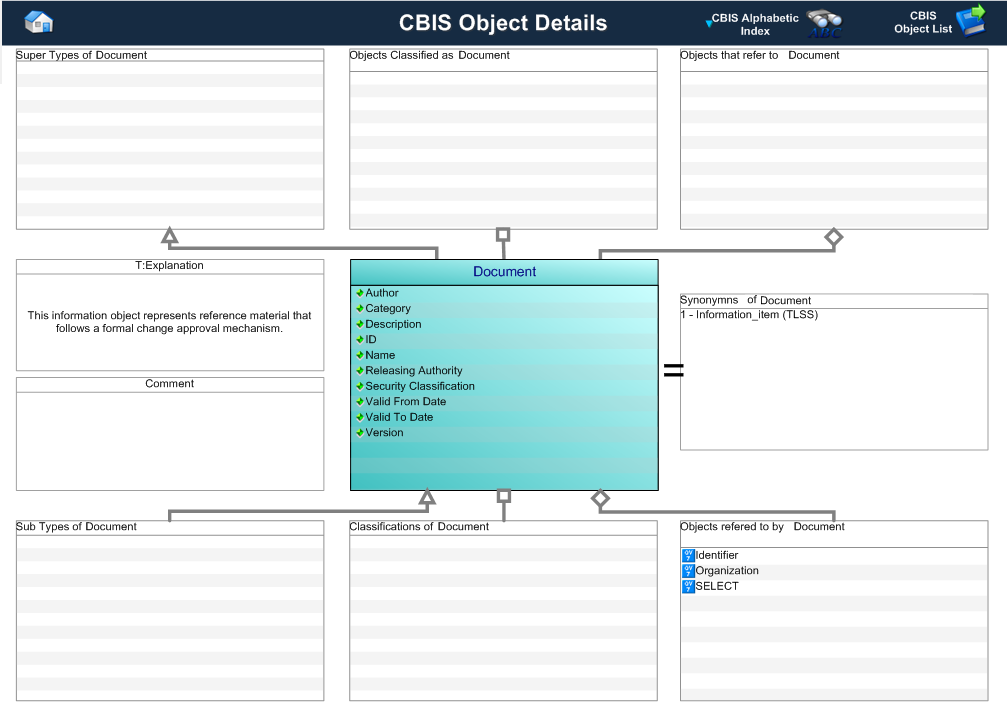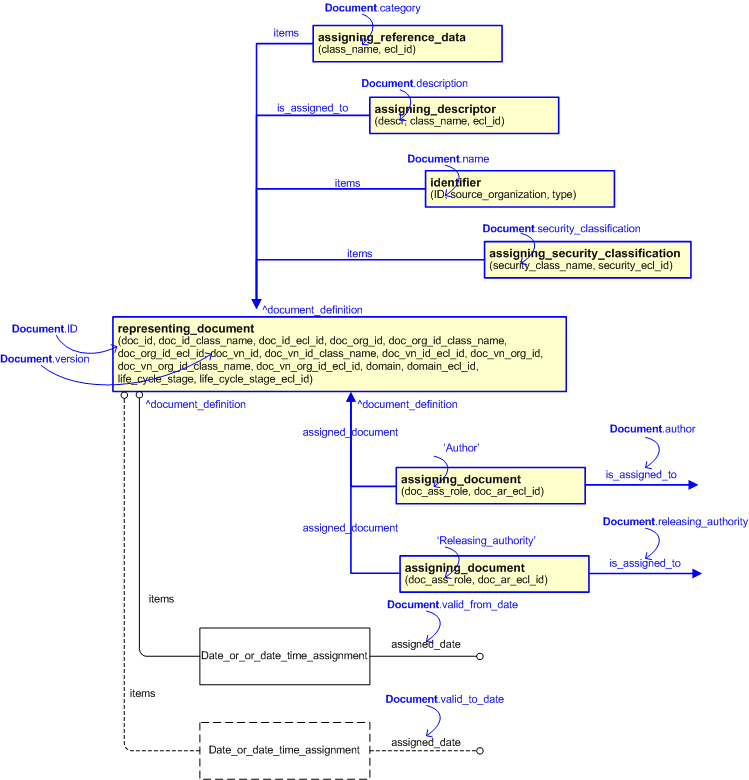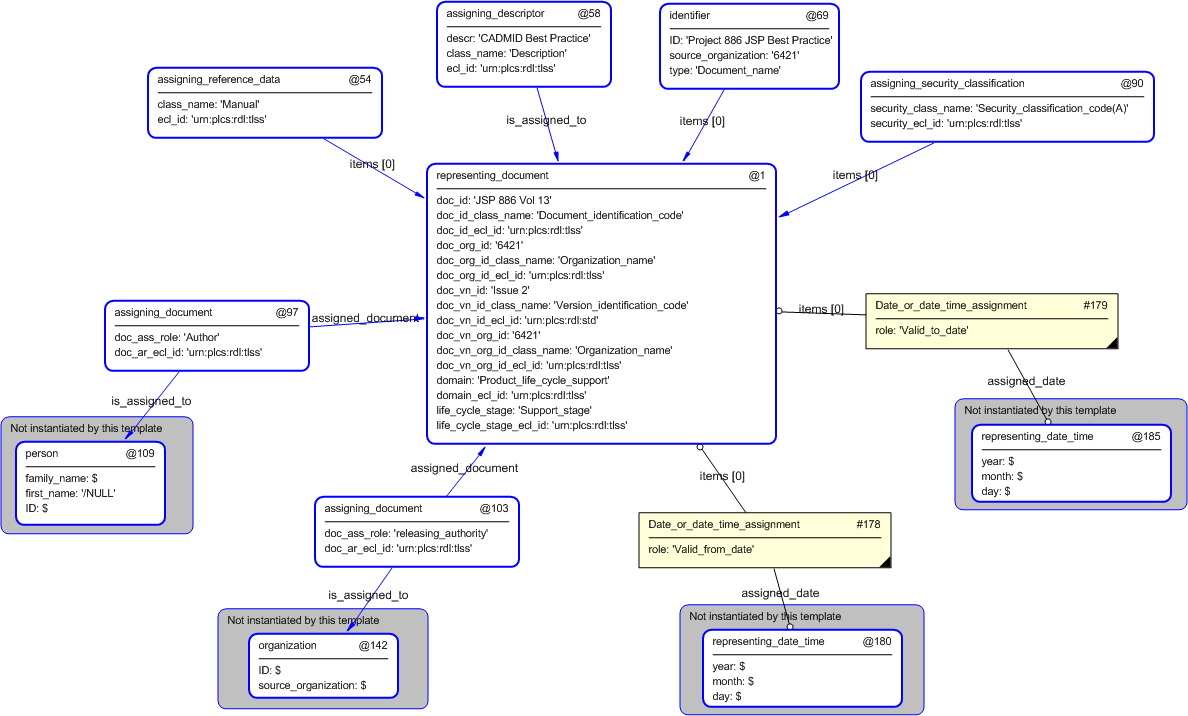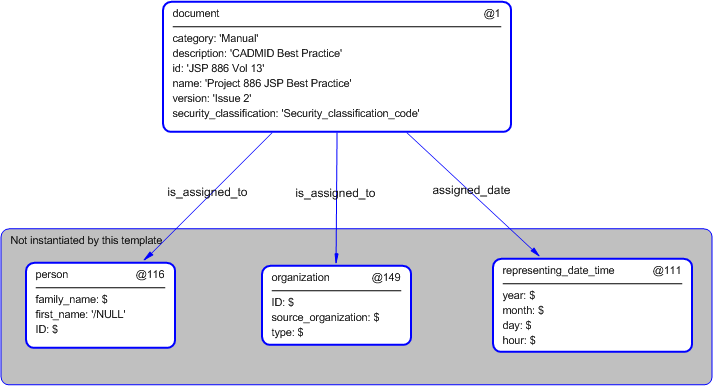Template:— document (doc)
Context:— UK_Defence |
Date: 2009/04/17 10:44:16
Revision: 1.3
|
This section specifies the template document.
NOTE
The template has been defined in the context of
UK_Defence.
Refer to the business context for details of related templates.
NOTE
An explanation of a template and the associated instantiation path is
provided in the
Template overview
section.
This template describes how to represent the UK_Defence concept of a document in terms of PLCS
model elements (templates, entities, and reference data).
This information object represents reference material that follows a formal change approval
mechanism.
The definition of the document object is: This information object represents reference
material that follows a formal change approval mechanism.
Figure 1 — Graphical Representation for Business Object Document
|
Attribute name
|
Attribute description
|
Attribute type
|
Optionality
|
| Author |
This is the reference to the author of the Document. |
Relationship to Person or Organization |
Mandatory (1:?) |
| Category |
This attribute provides the type of document. |
Intrinsic |
Mandatory |
| Description |
This attribute provides the description of the Document. |
Intrinsic |
Mandatory |
| ID |
This attribute provides the identification of the Document. |
Identifier |
Mandatory |
| Identifier.id |
This is the value of the id attribute of the Identifier applied to the
Document.
|
intrinsic |
Mandatory |
| Identifier.type |
This attribute is the type associated with the id of the Identifier given
to the Document. This must be one of the classes provided.
|
Document_identification_code |
Mandatory |
| Identifier.source_organization |
This attribute is the value representing the source organization that
provides the id of the Identifier given to the Document. This value is assumed to be a
type of Organization_identification_code.
|
Organization_identification_code |
Mandatory |
| Name |
This attribute provides the name of the Document. |
Intrinsic |
Mandatory |
| Releasing Authority |
This attribute identifies the Authority used to publish the Document. |
Relationship to Organization |
Mandatory |
| Security Classification |
This attribute provides the type of security clearance required to access
the Document.
|
Intrinsic |
Mandatory |
| Valid From Date |
This attribute provides the date from which the Document is valid for use. |
Intrinsic |
Mandatory |
| Valid To Date |
This attribute provides the date to which the Document is valid for use. |
Intrinsic |
Optional |
| Version |
This attribute provides the version information for the Document. |
Intrinsic |
Mandatory |
Table 1 — Document attribute details
The EXPRESS-G diagram in
Figure
2
shows the templates and EXPRESS entities that are required
to represent the template
"document".
The text highlighted in blue shows the template parameters.
The figure below is complex enough, so the default values and reference data values have been removed. It is possible to
determine these by looking at the instantiation path for each template occurrence where the class names and external class
library values are provided. These can also be seen in the instance diagram (see figure 5), although this also has values
provided from the input parameters.
Figure 2 — An EXPRESS-G representation of the Information model for document
The graphic for the template to be used in other EXPRESS-G diagrams
is shown in Figure
3
below.
Figure 3 — The graphical representation of the document template
The following input parameters are defined for this template:
The author of the document.
category (Default=Unknown_data_type,Type='CLASS')
The category of the document contents.
The description of the document.
The identifier of the document (Document_identification_code).
The name of the document.
An Organization representing the publishing authority of the Document. This attribute represents ownership and the authority
to release the document, even if the document has been prepared by a different organization.
The security classification of the Document. Actual sub-classification codes need to be determined by the exchange partners
and added to the reference data library.
The following classes and their sub-classes can be used:
classifications: [Security_classification_code]![[warning:]](../../../../../../images/dex/warning.gif) Error RDL4: The URI urn:plcs:rdl:uk_defence is not listed in dexlib/data/refdata/rdl_index.xml
Error RDL4: The URI urn:plcs:rdl:uk_defence is not listed in dexlib/data/refdata/rdl_index.xml
The valid from date of document.
The valid to date of document.
The version identifier of the document (Version_identification_code).
The following reference parameters are defined for this template:
Allow the
Document
entity instantiated in this path to be referenced when this template is used.
Note: The
Document
entity can be referenced in a template path by:
%^target = $document.document%
where
target
is the parameter to which the
Document
is bound.
Allow the
Document_version
entity instantiated in this path to be referenced when this template is used.
%^target = $document.document_version%
Allow the
Document_definition
entity instantiated in this path to be referenced when this template is used.
%^target = $document.document_definition%
The instantiation path shown below specifies the entities that are to be
instantiated by the template.
A description of templates and the syntax for the instantiation path is
provided in the
Templates Help/Information section.
-- instantiate representing_document /
representing_document(
doc_id=@id,
doc_id_class_name='Document_identification_code',
doc_id_ecl_id='urn:plcs:rdl:uk_defence',
doc_org_id=@releasing_authority,
doc_org_id_class_name='Organization_identification_code',
doc_org_id_ecl_id='urn:plcs:rdl:uk_defence',
doc_vn_id=@version,
doc_vn_id_class_name='Version_identification_code',
doc_vn_id_ecl_id='urn:plcs:rdl:uk_defence',
doc_vn_org_id=@releasing_authority,
doc_vn_org_id_class_name='Organization_identification_code',
doc_vn_org_id_ecl_id='urn:plcs:rdl:uk_defence',
domain='Product_life_cycle_support',
domain_ecl_id='urn:plcs:rdl:uk_defence',
life_cycle_stage='Support_stage',
life_cycle_stage_ecl_id='urn:plcs:rdl:uk_defence')/
-- assign ref parameters %^document = $representing_document.document%
%^document_version = $representing_document.document_version%
%^document_definition = $representing_document.document_definition%
-- category /
assigning_reference_data(
items=^document_definition,
class_name=@category,
ecl_id='urn:plcs:rdl:uk_defence')/
-- description /
assigning_descriptor(
descr=@description,
class_name='Description',
ecl_id='urn:plcs:rdl:uk_defence',
is_assigned_to=^document)/
-- document name /
identifier(
ID=@name,
source_organization=@releasing_authority,
type='Document_name',
items=^document)/
-- security classification /
assigning_security_classification(
security_class_name=@security_classification,
security_ecl_id='urn:plcs:rdl:uk_defence',
items=^document)/
-- author /
assigning_document(
doc_ass_role='author',
doc_ar_ecl_id='urn:plcs:rdl:uk_defence',
assigned_document=^document_definition,
is_assigned_to=@author)/
-- releasing authority /
assigning_document(
doc_ass_role='author',
doc_ar_ecl_id='urn:plcs:rdl:uk_defence',
assigned_document=^document_definition,
is_assigned_to=@releasing_authority)/
-- valid from date Date_or_date_time_assignment%^valid_from_date =
Date_or_date_time_assignment%
^valid_from_date.assigned_date ->
@valid_from_date
^valid_from_date.role = 'document_valid_from_date'
^valid_from_date.items ->
^document_definition
-- valid to date Date_or_date_time_assignment%^valid_to_date =
Date_or_date_time_assignment%
^valid_to_date.assigned_date ->
@valid_to_date
^valid_to_date.role = 'document_valid_to_date'
^valid_to_date.items ->
^document_definition
The following entities are instantiated with attributes as specified:
The instance diagram in Figure
4
shows an example of the EXPRESS entities and templates that are instantiated by the template:
/document(author='#109', category='Manual', description='CADMID Best Practice', id='JSP 886 Vol 13', name='Project 886 JSP Best Practice', releasing_authority='#142', security_classification='Security_classification_code(A)', valid_from_date='#180', valid_to_date='#185', version='Issue 2')/
(an illustration of the consolidated document template is shown in
Figure
5 below.)
Figure 4 — Entities instantiated by document template
The instance diagram in
Figure
5
shows the graphic symbol for the template that is to be
used in other instance diagrams. The example template is:
/document(author='#109', category='Manual', description='CADMID Best Practice', id='JSP 886 Vol 13', name='Project 886 JSP Best Practice', releasing_authority='#142', security_classification='Security_classification_code(A)', valid_from_date='#180', valid_to_date='#185', version='Issue 2')/
Figure 5 — Instantiation of document template
Characterizations
No common characterizations of the template
document
have been identified. However, the ISO 10303-239 EXPRESS model
may enable other assignments to the entities instantiated by the template.




